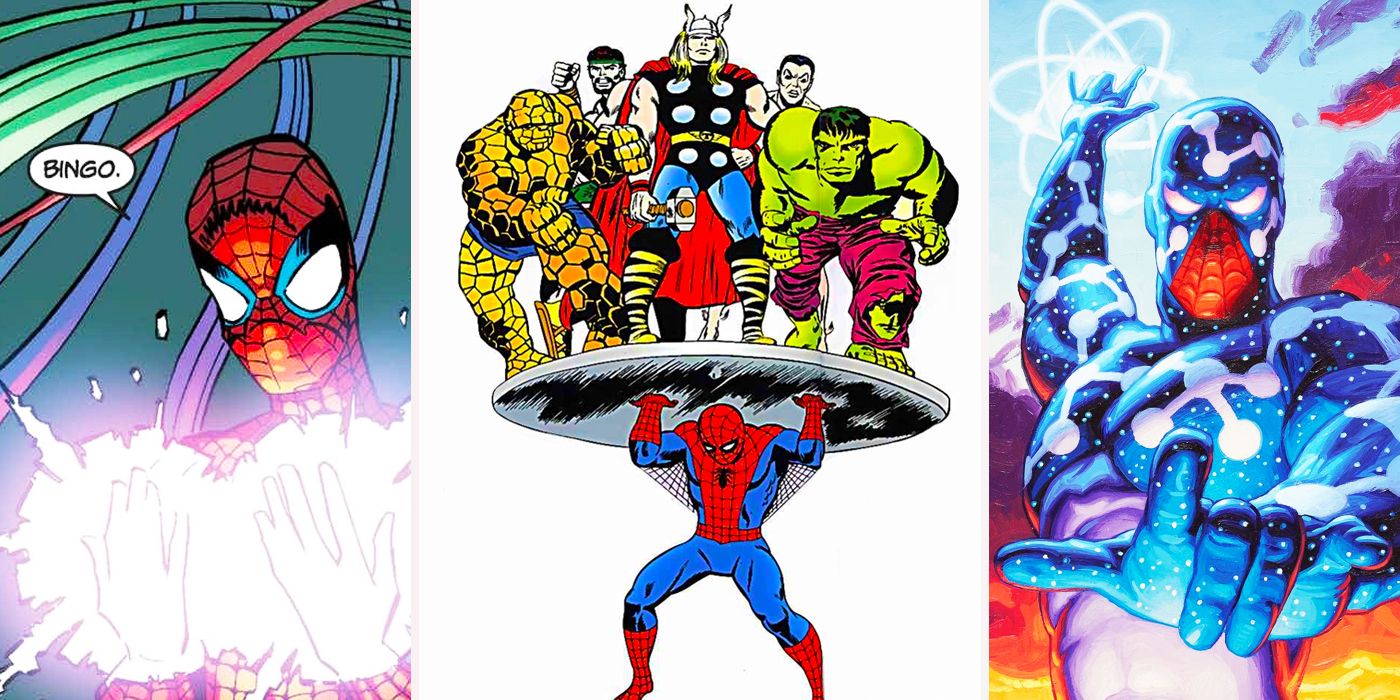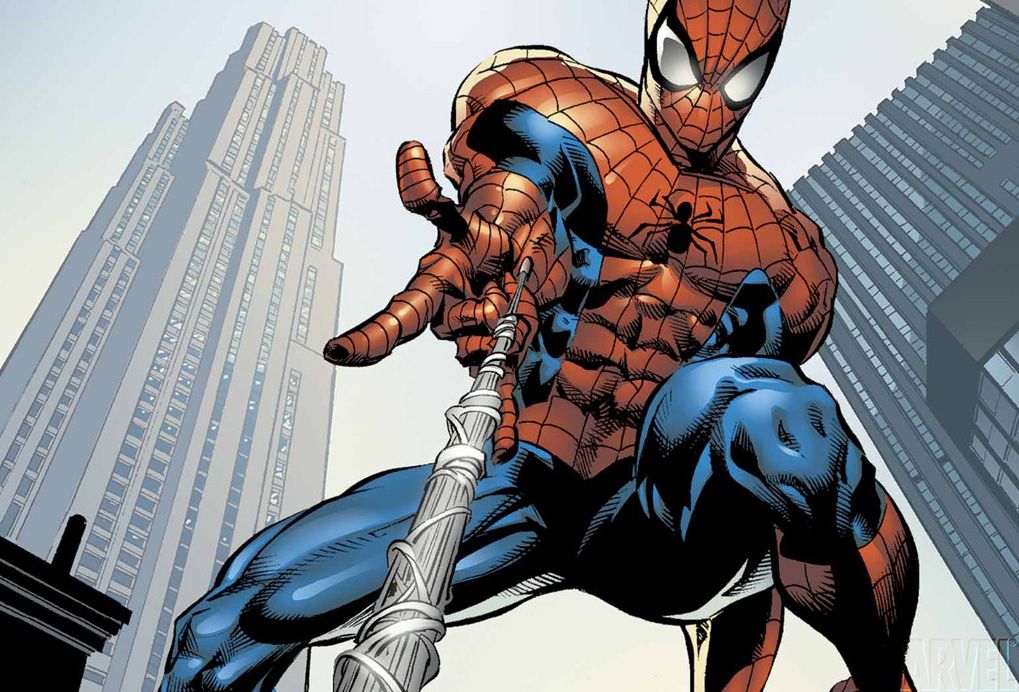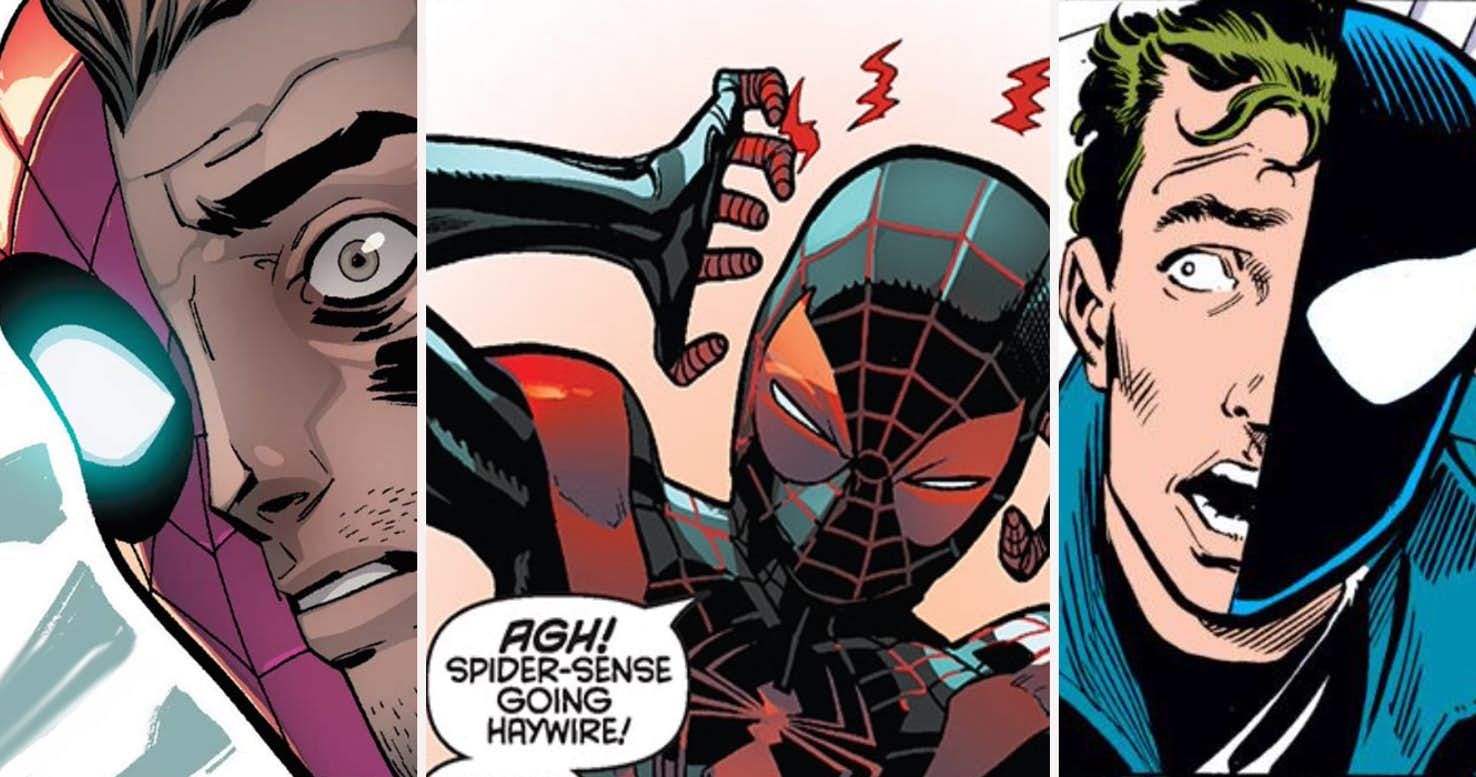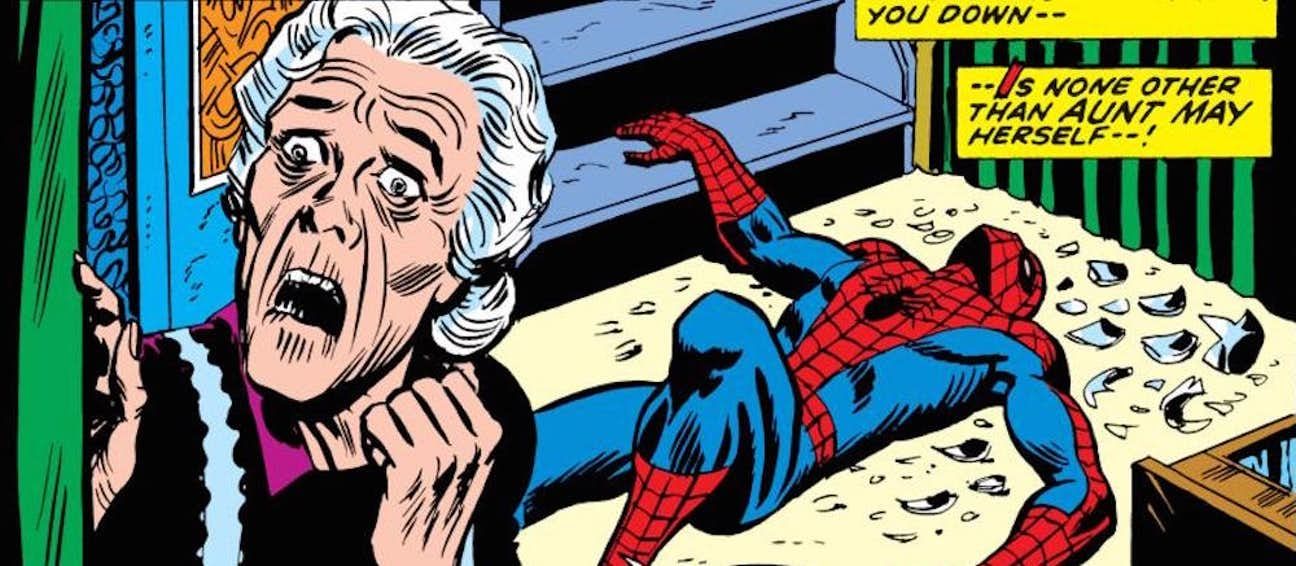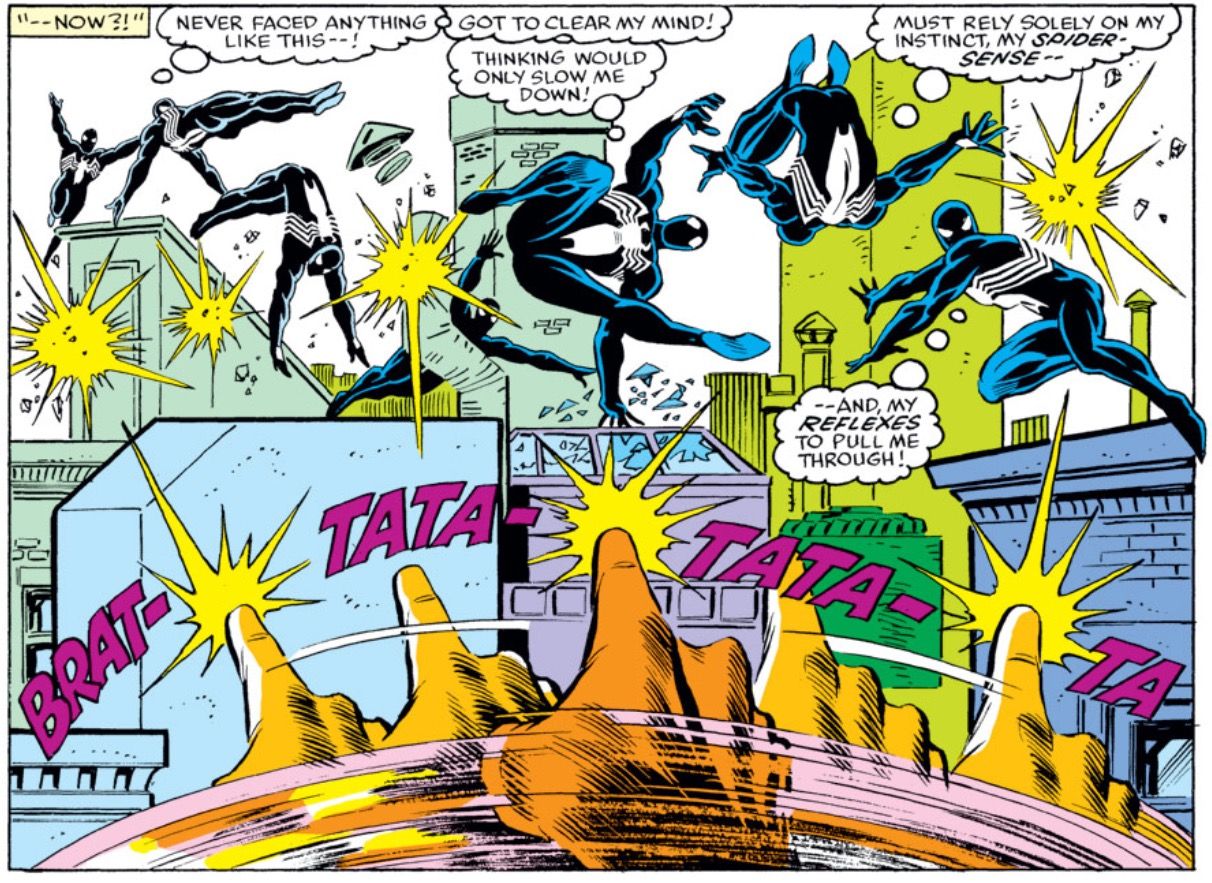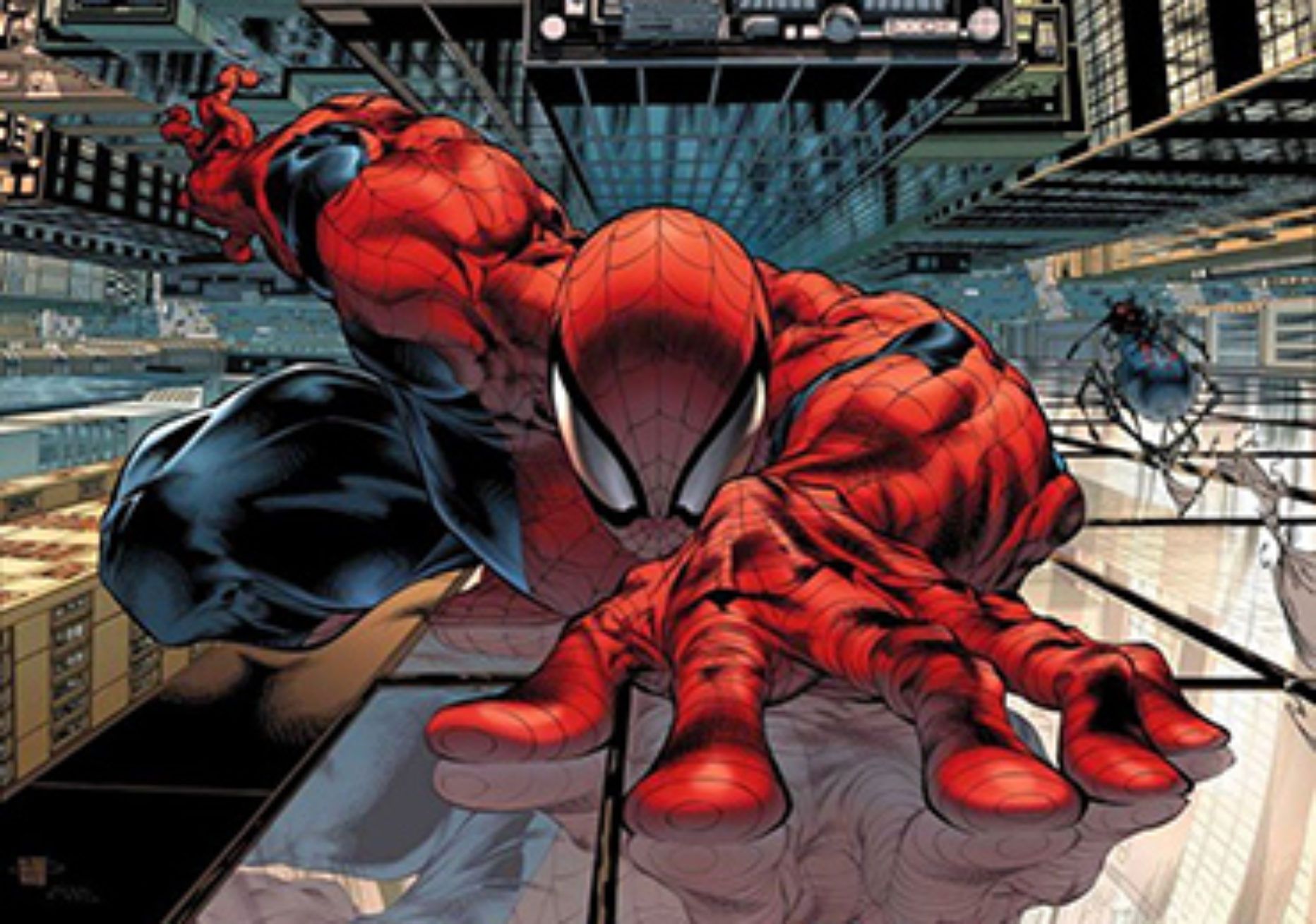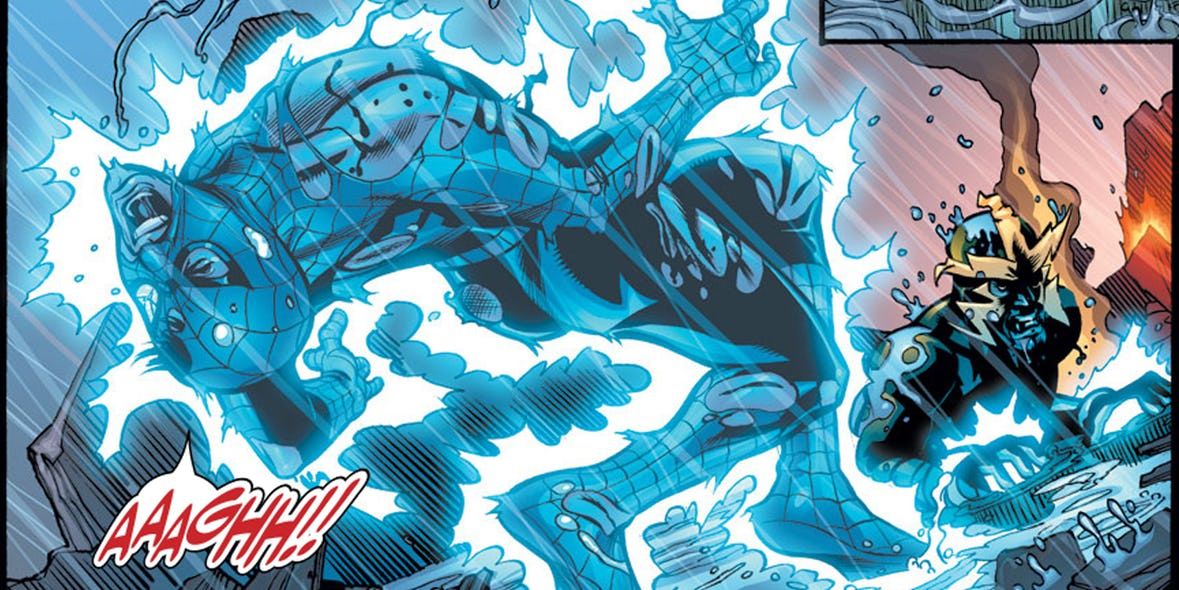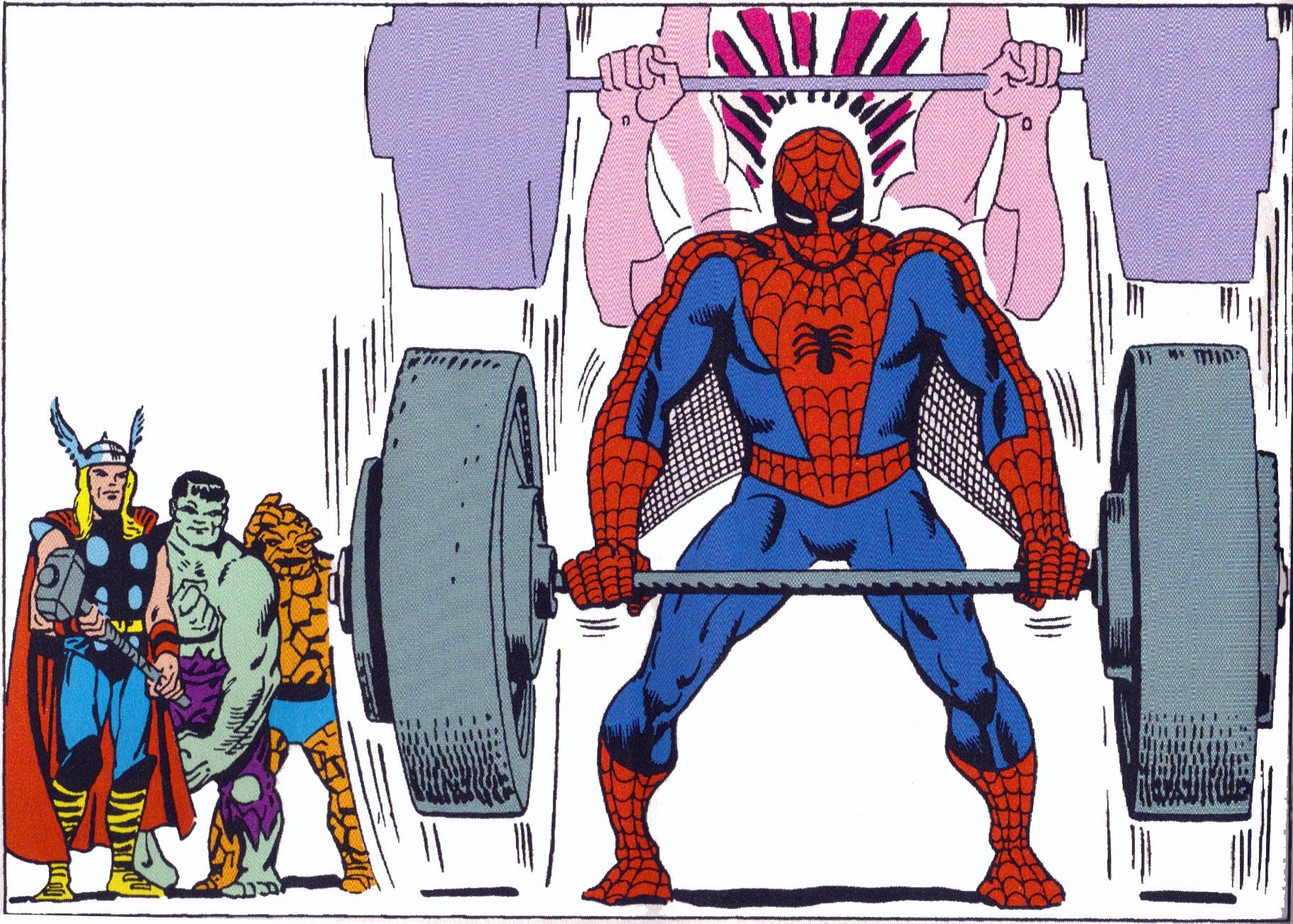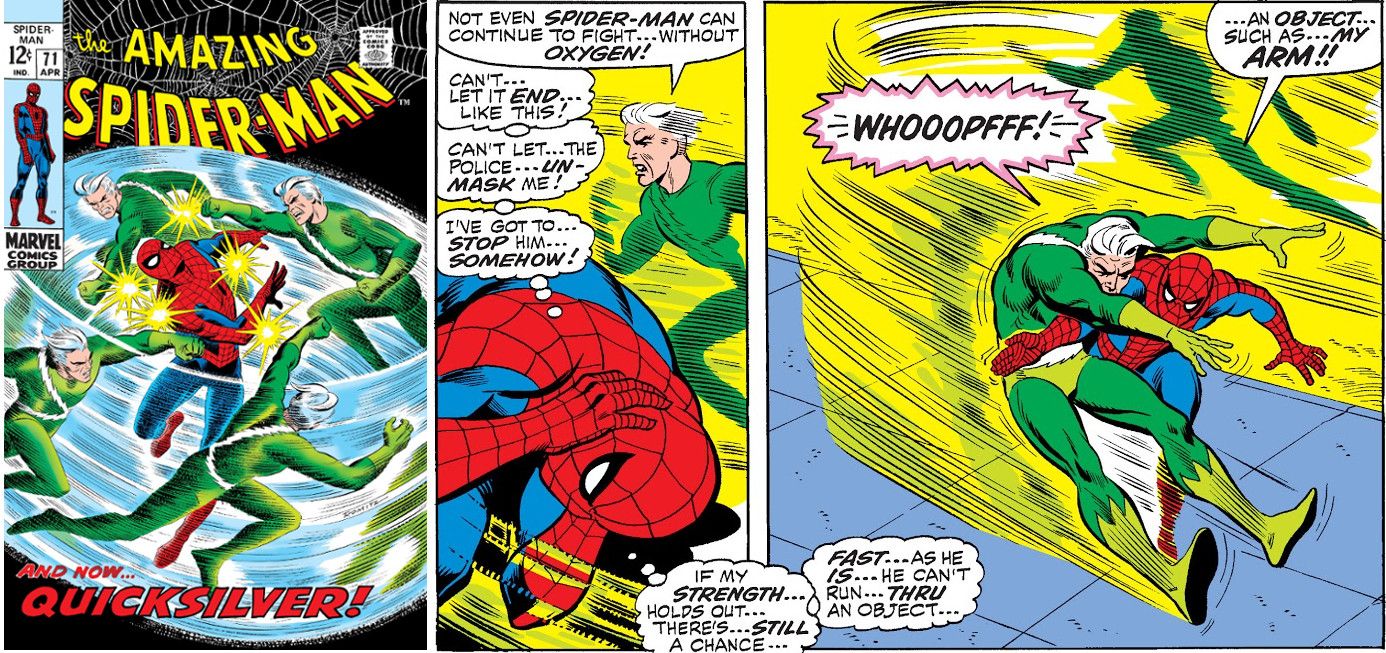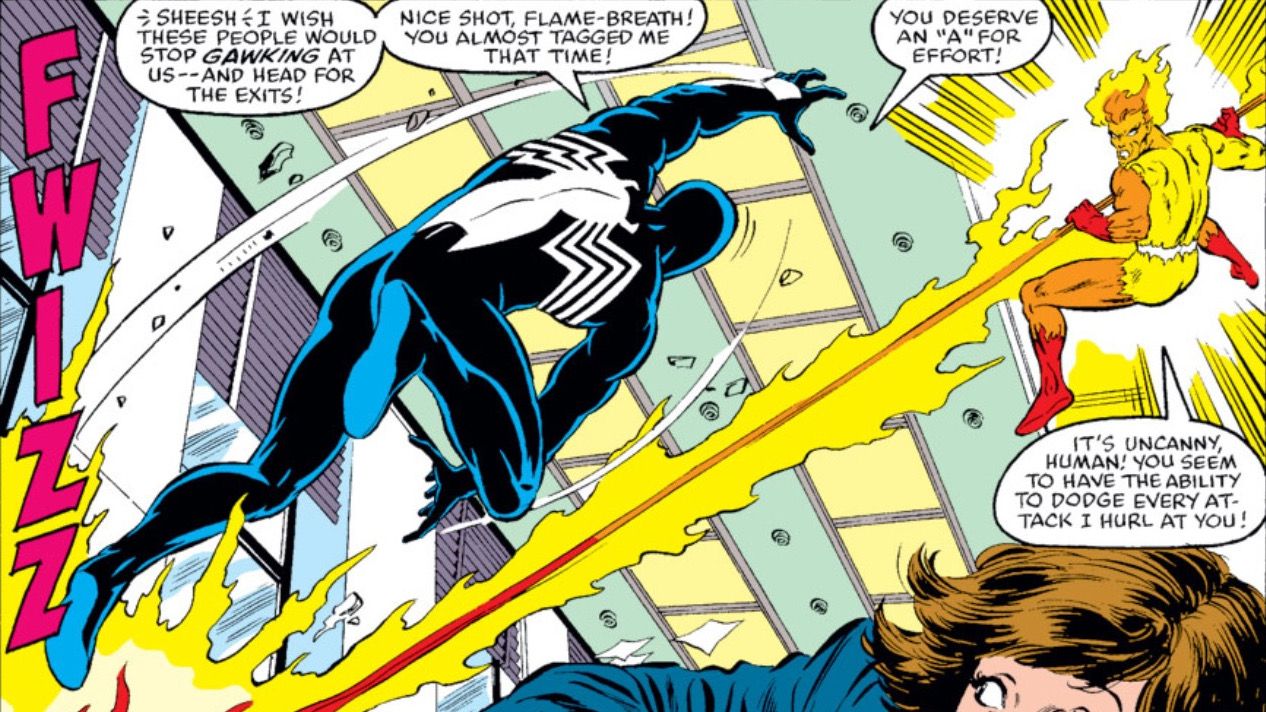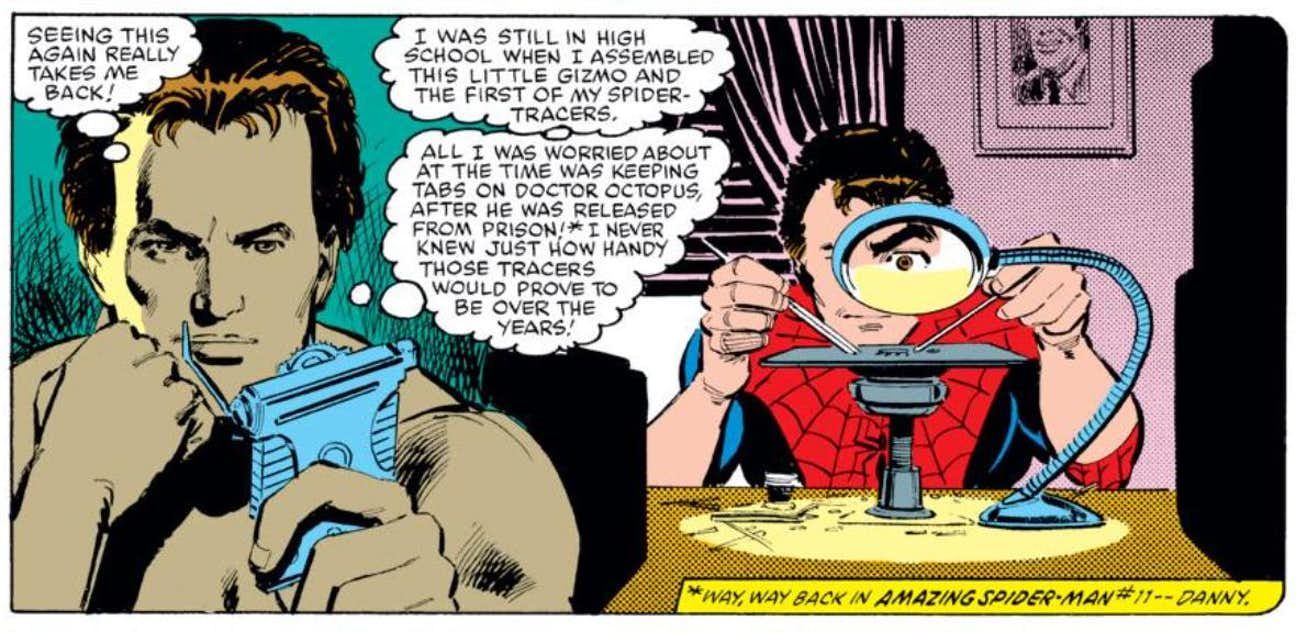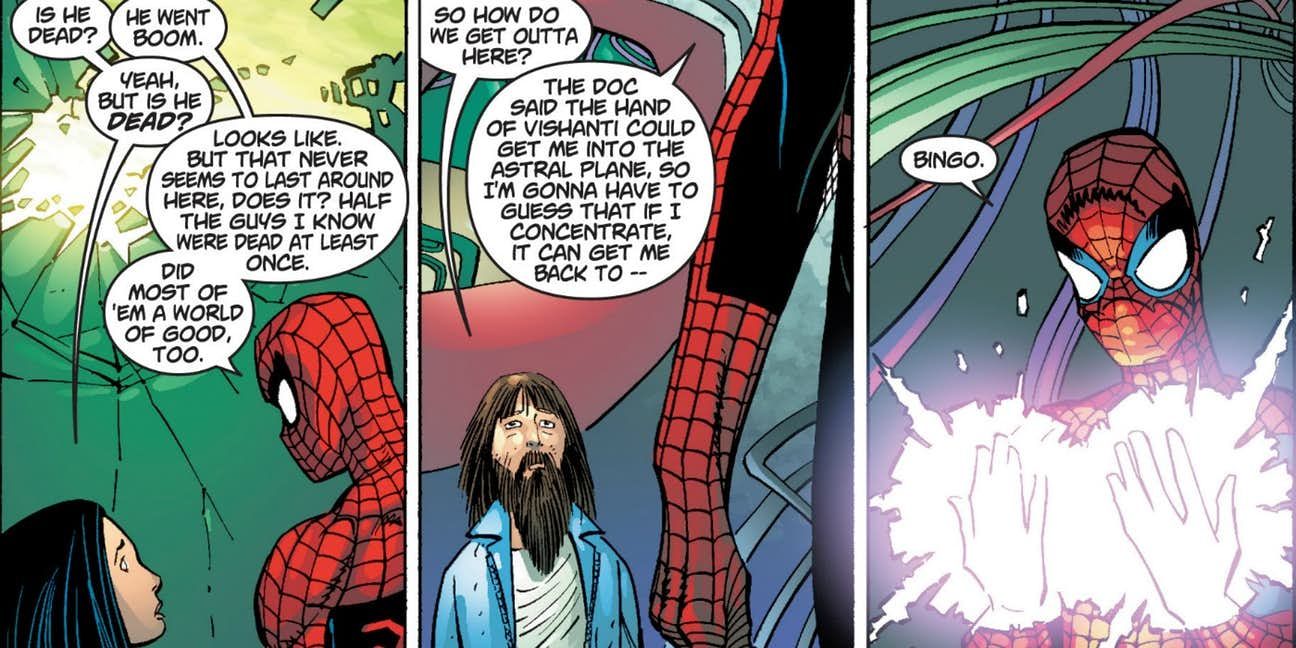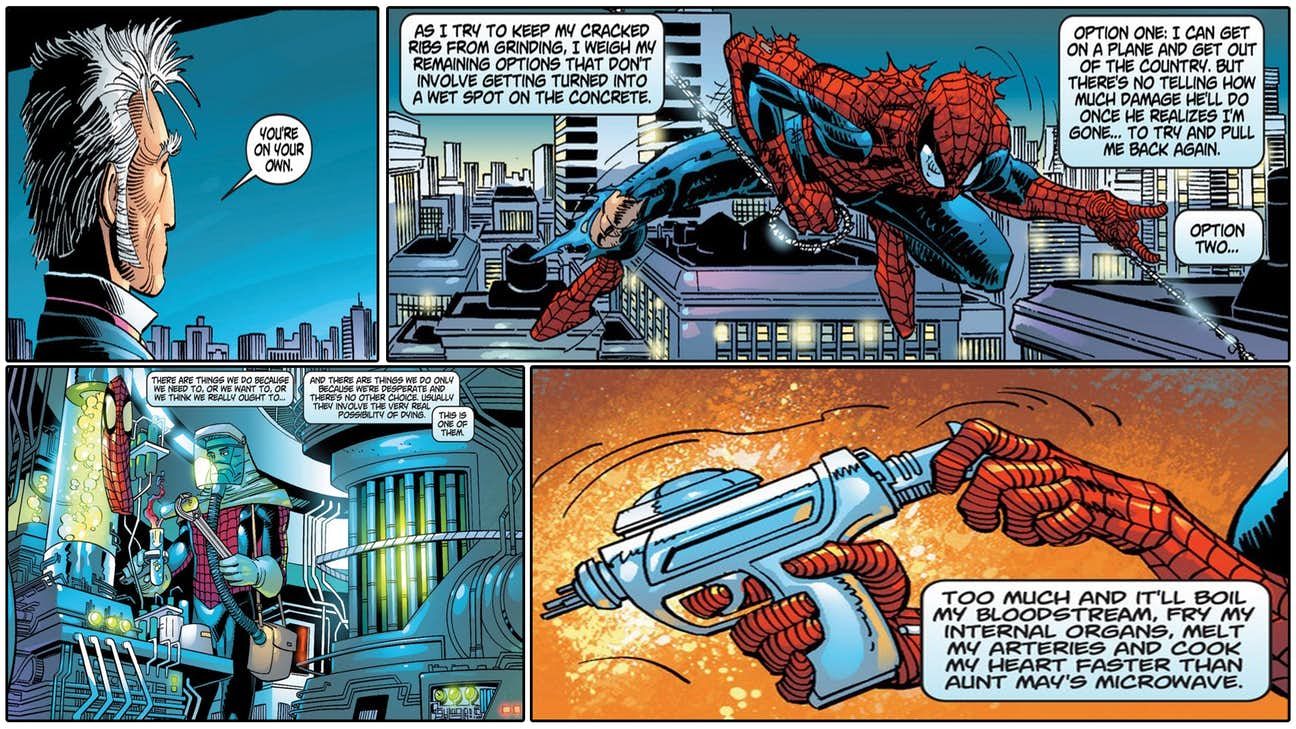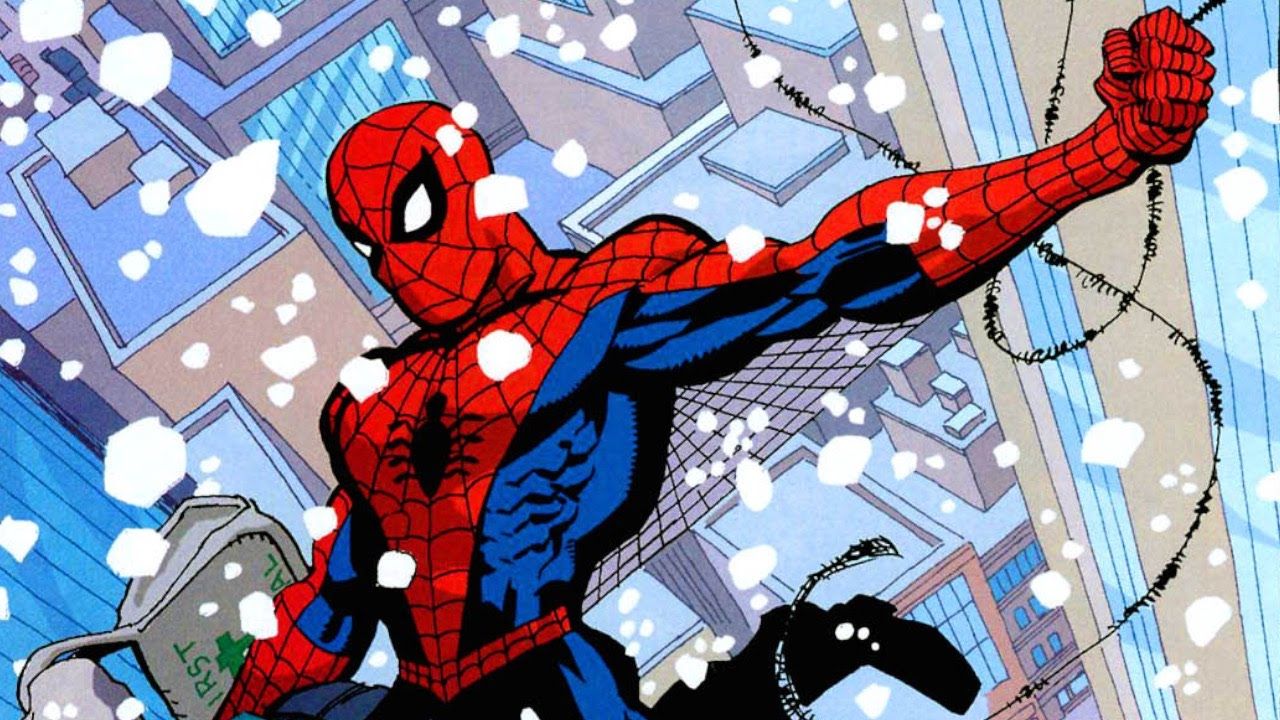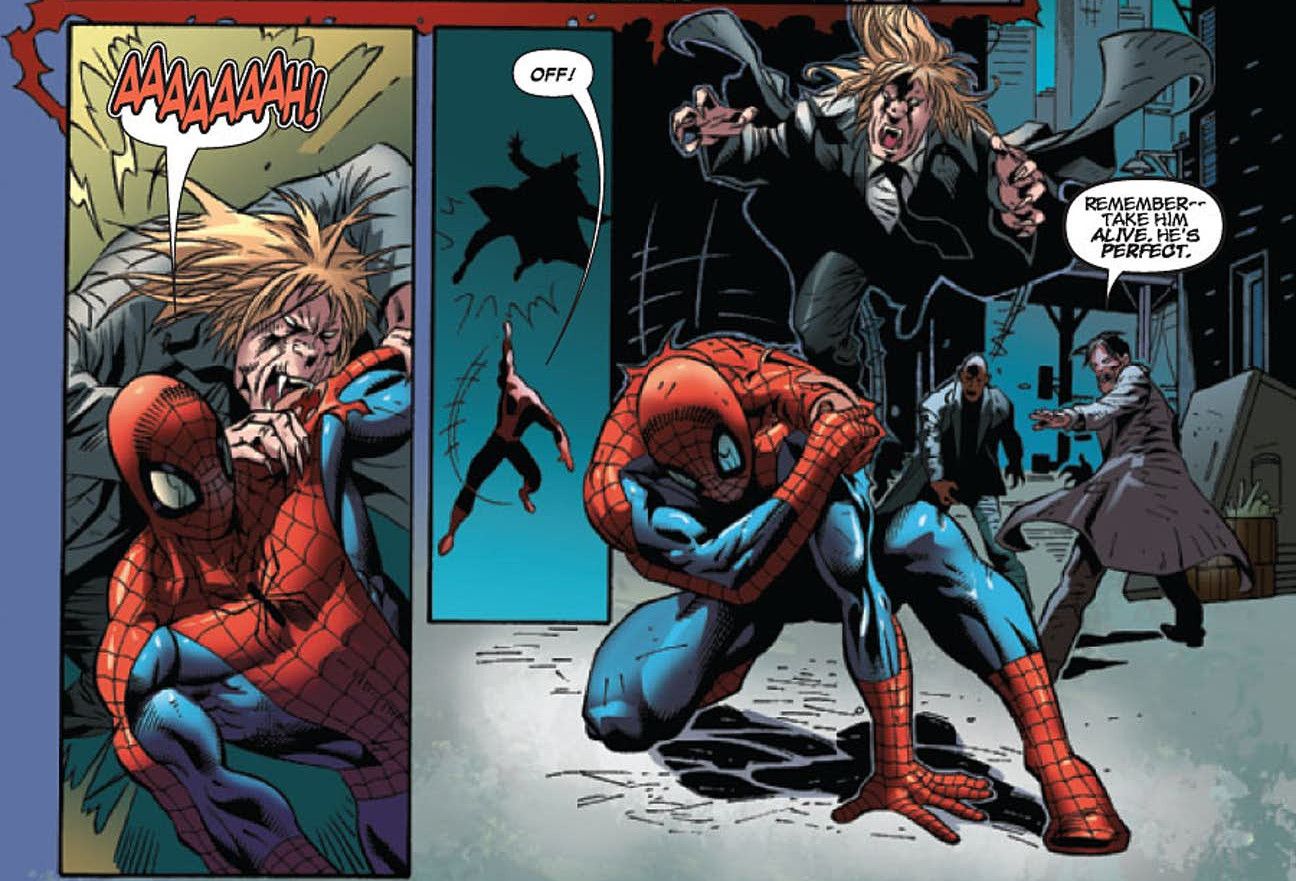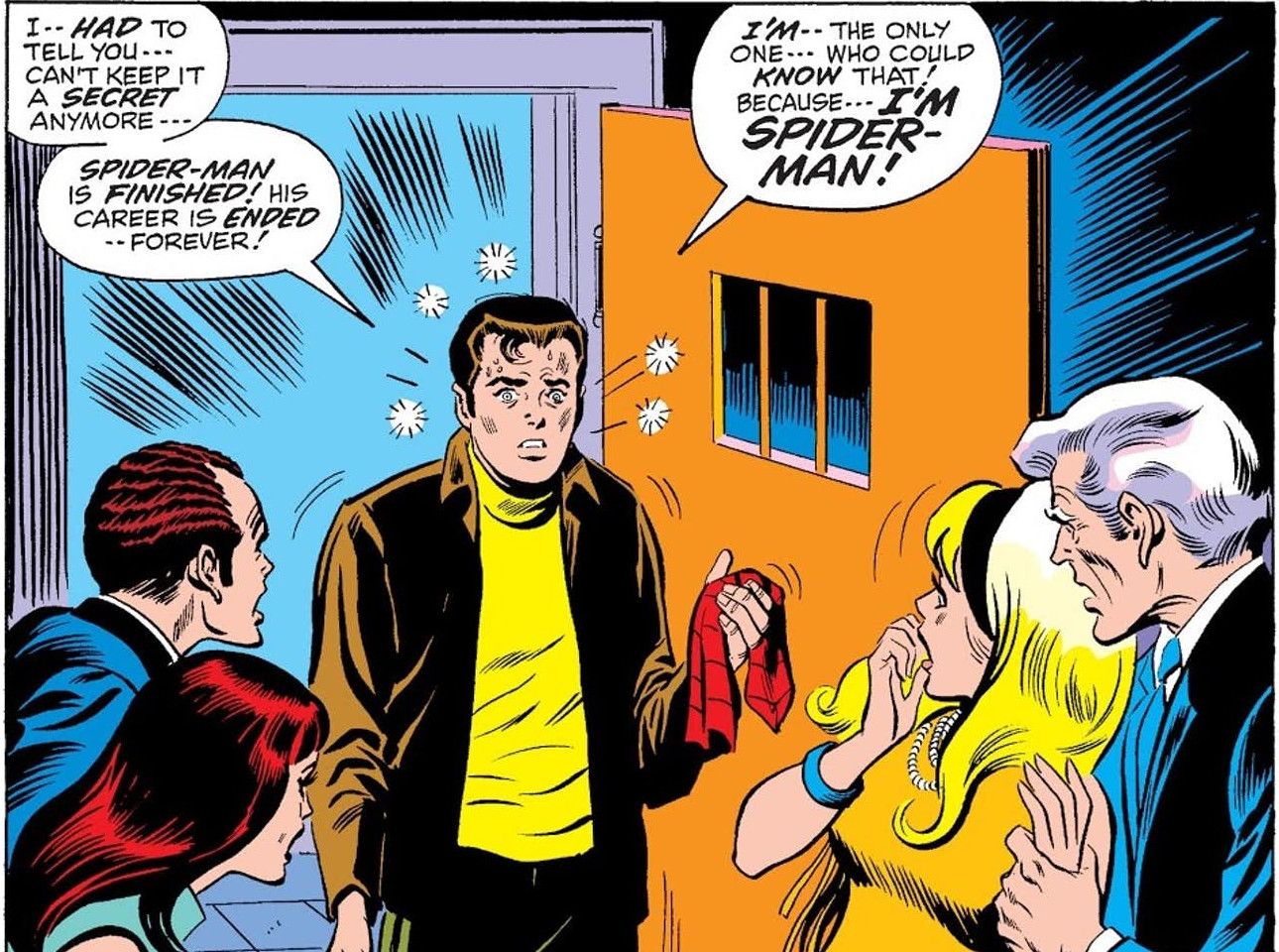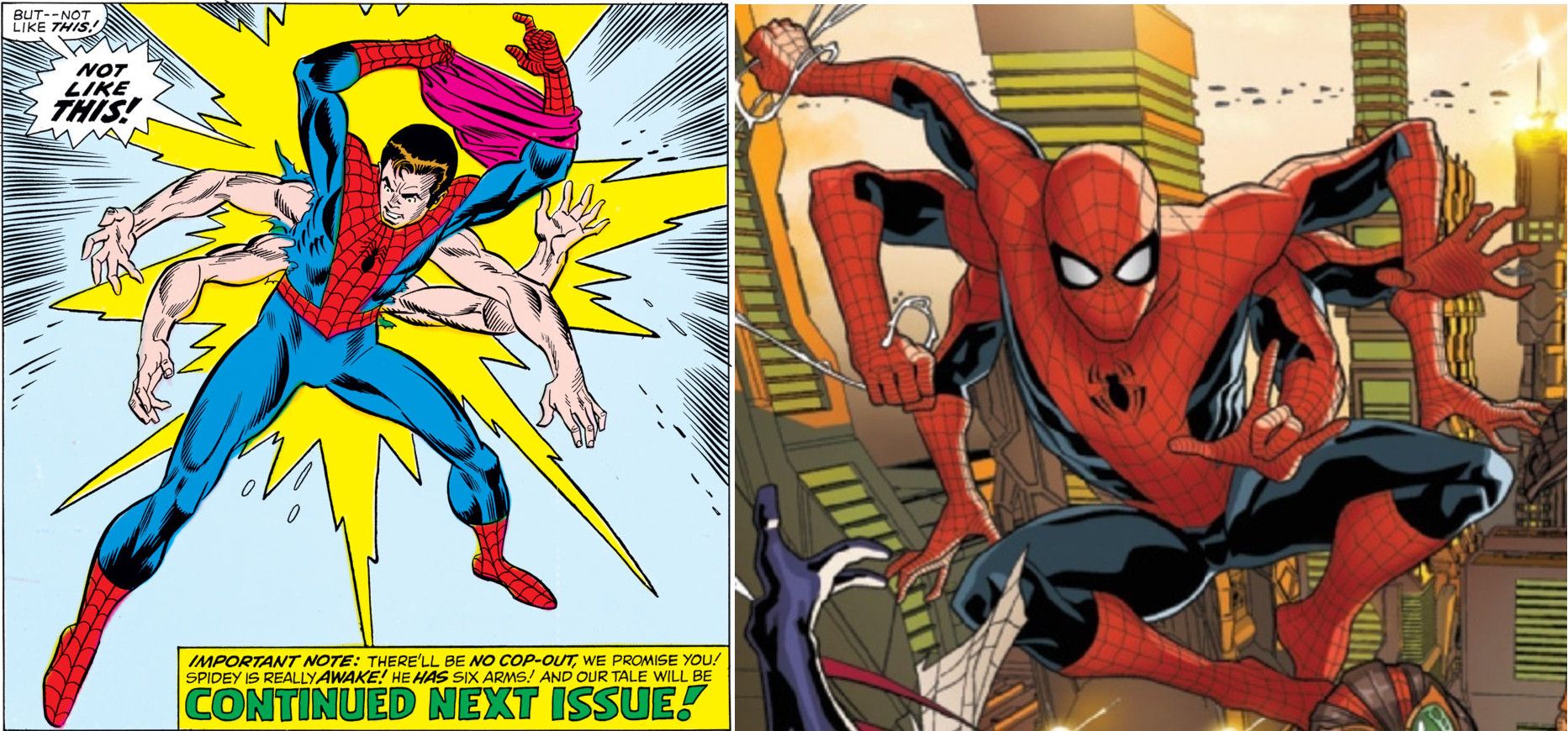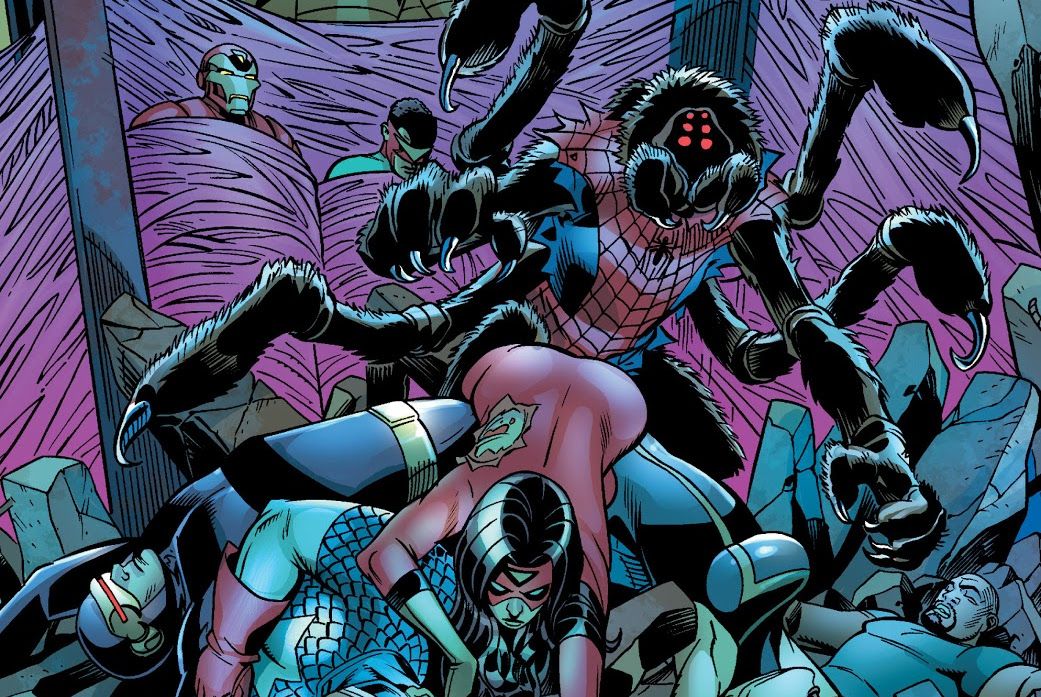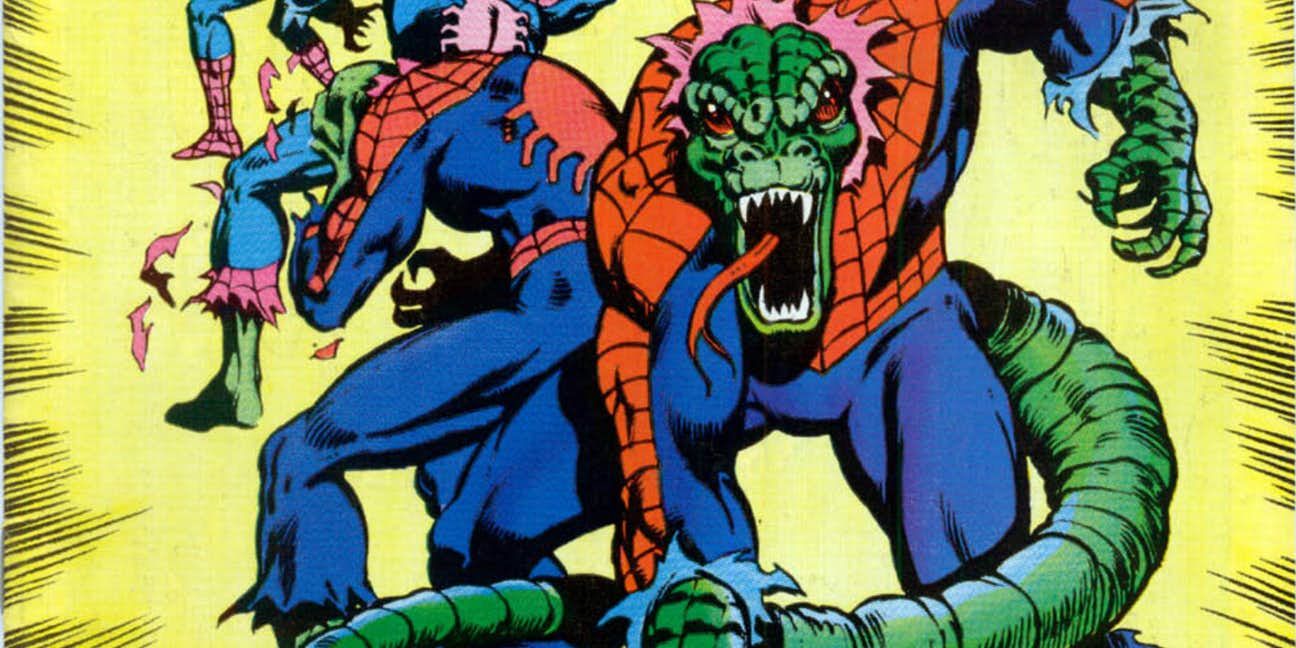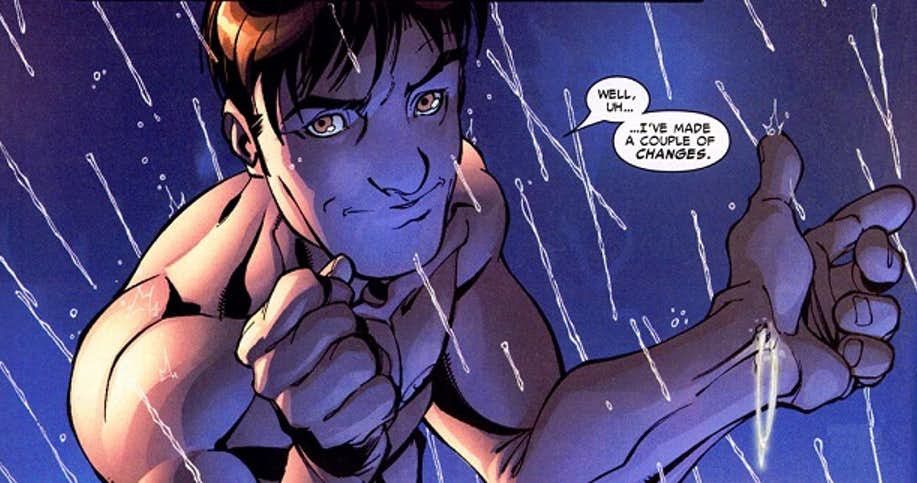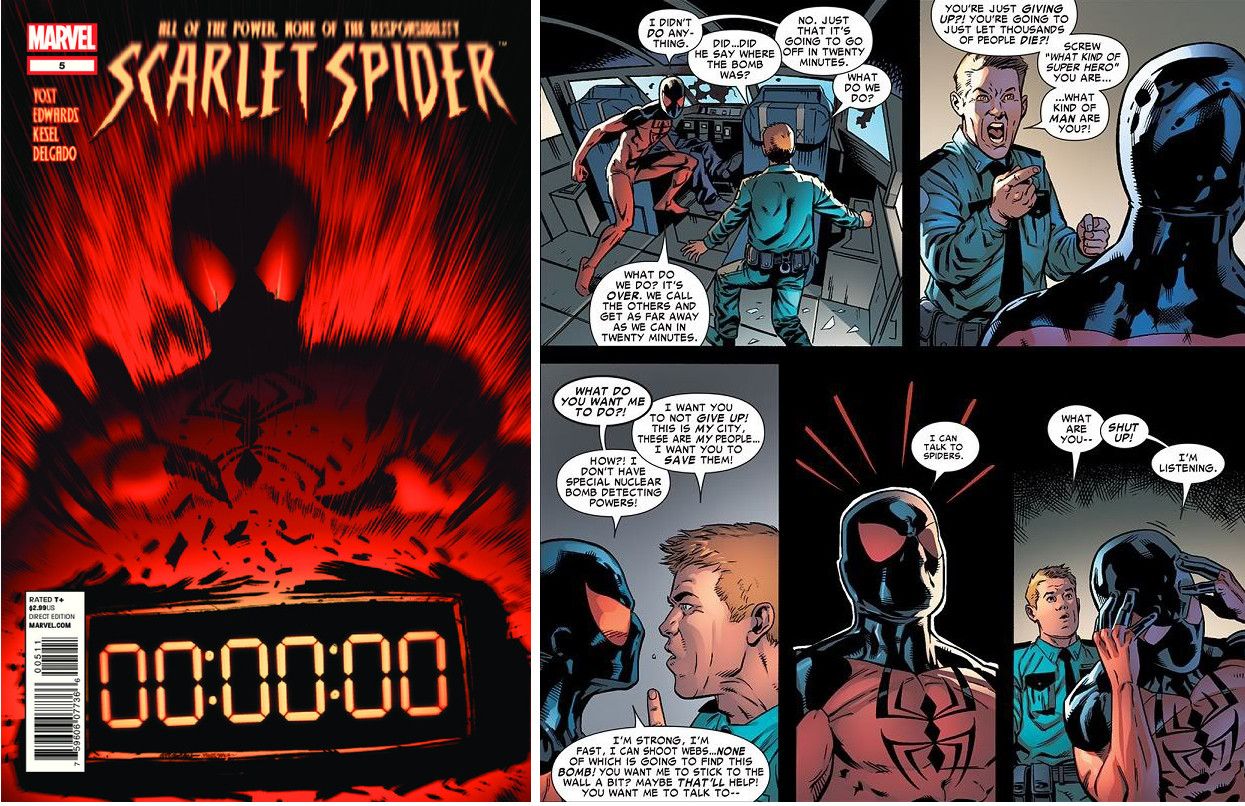Ever since he first came on the scene, Spider-Man was a fresh idea in comics: a teen hero who was the headliner in his title, not a sidekick, but with plenty of room to grow. And grow he did, with an array of powers unlike those of other superheroes of the day, including the ability to cling to and crawl on walls and a "spider-sense" that warns him of impending danger. These, coupled with enhanced strength, lightning-fast reflexes, extraordinary stamina and more allow Spider-Man to take on and defeat villains with greater power and more murderous intentions. But Spider-Man has talents that they don't, like truly superhuman levels of determination, heart, ingenuity, and an innate ability to adapt to situations on the fly.
Spider-Man has not only learned how to get greater use from his original skill set, he has over the years gained new powers, as well. Some of his adventures have transformed his body and challenged him to keep his mind -- and his humanity -- as sharp and intact as possible. Things like organic web shooters, night vision and the ability to communicate with spiders have made Spider-Man even more formidable. Here are 25 things only true believers know about Spider-Man's superpowers.
25 ENHANCED PHYSIOLOGY
The bite from the spider transformed Peter Parker's whole body, so that all of his senses -- smell, touch, taste, hearing, sight, sound, and all the others -- are enhanced to superhuman levels. Early in his career, in Amazing Spider-Man (Volume 1) #8 (January 1964), high-school bully Flash Thompson broke Peter Parker's eyeglasses and challenged him to a fight, leading Parker to the discovery that he now had 20/20 vision and no longer needed glasses at all. Luckily for Spider-Man, he bulked up without needing to hit the gym, and his skeleton, connective tissues and nervous system all changed to support his new physique.
This allows him to take great punishment during his battles with villains.
He has been battered by the Juggernaut and the Hulk, stomped by Goliath, shot by Bullseye, and worse. Many times, he has fought opponents while suffering broken ribs, and broken arms. In Spider-Man Unlimited (Volume 3) #6 (January 2005), a doctor straight-out tells him, "Simply put, it is humanly impossible for any normal man to sustain the amount of physical damage you've suffered and lived -- which leads me to conclude that you are not a normal man, and that you engage in risky activities."
24 SPIDER-SENSE
The most well-known of Spider-Man's abilities is his spider-sense, which first showed up in his first appearance in Amazing Fantasy #15 (August 1962), when he absentmindedly crossed the street, almost got hit by a car, and instinctively jumped out of its way. The spider-sense warns him of impending peril, either when he enters the vicinity of someone who means to do him harm, or when a threat comes close to him. It manifests itself as a tingling at the back of his head, but its intensity can increase with the nature and the power of the threat. For a minor problem, the spider-sense can be mild; for a major danger or a potential life-threatening situation, it can flare up as painfully as a migraine headache.
The spider-sense is helpful to Spider-Man in other ways. He invented his spider-tracers, miniature transmitters that emit signals over great distances. The tracers are small, about the size of a nickel, so they can be attached to someone he wishes to follow without their noticing -- most of the time. Initially, Spider-Man needed to have a receiver to get the signals from the tracers, but he tinkered with them until he could track them directly using his spider-sense.
23 SPIDER-SENSE FAILURES
As wonderful as Spider-Man's spider-sense is, there are several drawbacks. One is that it is very inconsistent. It can give Spider-Man a feeling that something bad might be happening soon, but it is non-specific. Another is that it doesn't trigger with some people or beings who are very familiar to him, even if they are dangerous or mean to do him harm. The spider-sense failed to react to the Jackal in Amazing Spider-Man (Volume 1) #148, just before he unmasked and revealed himself to be Miles Warren, Peter Parker's teacher. The sense didn't trigger around Greg Salinger, the murderous Foolkiller, in Amazing Spider-Man (Volume 1) #225-226 (February-March 1982), because he was one of Peter Parker's students. One time, in Amazing Spider-Man (Volume 1) #114 (November 1972), he got knocked unconscious by Aunt May!
Yup, his darling aunt clobbered Spidey upside the head with a vase in Doctor Octopus' hideout, and he never saw it coming.
Thanks to his time being bonded to the Venom symbiote, Spider-Man cannot detect it. And there are villains who have neutralized the power. In Amazing Spider-Man (Volume 1) #39 (August 1966), the Green Goblin invented a gas that took away Spider-Man's powers. Other villains who have negated the spider-sense are Mysterio and Kraven the Hunter. During the Spider Island storyline, he trained with Shang-Chi, the Master of Kung-Fu, to learn how to function without the spider-sense.
22 BALANCE AND ACROBATICS
There's no answer for how many angels can balance on the head of a pin, but one Spider-Man could definitely do it if he wanted to. He once balanced himself on one finger atop a flagpole just for kicks. He also can keep upright on his webs, of course, and once dealt with a ninja who was on a tightrope, freely leaping on and off the cable to disorient his opponent. This sense of balance, which even works when he is on his back, allows him to fearlessly swing through the city, and it helps him with his acrobatics.
Spider-Man dances around attackers almost without thinking. He easily dodges flying projectiles, such as throwing stars that were tossed at him by Bullseye in Peter Parker: Spider-Man (Volume 2) #6 (June 1999), in a story written by Howard Mackie, drawn by John Romita Jr. and inked by Scott Hanna. Once, in Friendly Neighborhood Spider-Man #1 (December 2005), he caught a bullet fired at him in his gloved hands. He is nimble enough to evade Doctor Octopus and his mechanical arms while also being sharp enough to bounce in a pattern that tangled them, in Amazing Spider-Man (Volume 1) #647 (December 2010), written by Fred van Lente and drawn by Max Fiumara.
21 WALL-CRAWLING
Spider-Man is able to cling to walls instinctively, as he did in his first appearance in Amazing Fantasy #15 (August 1962). But that ability has developed so that he has conscious control over his body's cling to other surfaces. When he wills it, his body forges an unbreakable bond with what he's attached to -- so much so that if an opponent tries to pull him away, the surface will break instead. At first, Spider-Man was able to cling with his hands and feet, but things have changed!
This ability manifests through his entire body, which allows him to walk on ceilings or rest on his back on a wall without falling to the ground.
In Marvel Adventures Super Heroes #1 (September 2008), in a story written by Paul Tobin, penciled by Alvin Lee and inked by Terry Pallott, a curious Iron Man wants to test just how strong Spider-man's clinging ability is. "Interesting. That's glass. A sheer surface. And you're not even sliding around?," he asks. "Not at all. Here. Push me a little," Spider-Man responds. Iron Man does, and Spider-Man doesn't move. To further prove his prowess, Spider-Man clings to the Hulk, who just happens to be hanging around nearby, eating a pizza.
20 CAN'T STICK TO EVERYTHING
Spider-Man's clinging ability is wonderful and extensive, but it is not unlimited. There are differing explanations of how it works. Real spiders cling to surfaces thanks to tiny, barbed hairs on their extremities. They are able to cling to sheer surfaces like glass thanks to the van der Waals force, which creates a bond at the molecular level. Spider-Man, however, is far bigger than an ordinary spider, so the bond must be stronger to be able to support his weight. Plus, he is able to do his climbing even while wearing gloves and his costume boots, which are rather thin. Spider-Man's wall-crawling ability is described in The Official Handbook to the Marvel Universe as him controlling "the inter-atomic attraction (electrostatic force) between molecular boundary layers."
Unfortunately, some of Spider-Man's enemies have found ways to thwart this ability. Electro once disrupted it after concluding that Spider-Man's power worked through electromagnetic bonding. He did it by absorbing the static electricity in the immediate vicinity, making Spider-Man unable to climb the walls. Other villains, such as Stilt Man and Paste-Pot Pete (who, wisely, came up with a different name, The Trapster) have gone the low-tech route, using lubricants to stop Spider-Man from clinging to surfaces.
19 STRENGTH
Spider-Man freely, frequently describes himself as having the proportionate strength of a spider, but he is far stronger than that. Some varieties of spider can hold up 170 times their body weight, meaning a 150-lb. person could hold 25,000 lbs. Spider-Man has the ability to hold 10 tons, although some references say he can do as much as 25 tons. This still doesn't put him in the class of powerhouses like Thor
It does put him far above people with un-enhanced human-level strength like Daredevil and Captain America.
He has been able to take on even stronger opponents. In Amazing Spider-Man (Volume 1) #120 (May 1973), he went up against the Incredible Hulk. One of his most well-known moments came in Amazing Spider-Man (Volume 1) #33 (February 1966), in a story written by Stan Lee and drawn by Steve Ditko. In the previous issue, he battled the Master Planner -- who was revealed to be Doctor Octopus -- in his secret base, which was under a river. The fight ended with Spider-Man trapped under rubble, with water rushing in. Thoughts of how much his Aunt May needed him kept him going, and helped him find the strength to throw off the wreckage and get free.
18 ENHANCED SPEED
The world knows that Superman is faster than a speeding bullet, but he's not the only superhero in red and blue who can outpace gunfire. Spider-Man frequently jumps around as bad guys fire at him, dodging their fire. And with the proportionate strength of a spider comes proportionate speed, which scaled up to human size is estimated in the range of 19o-plus mph. This isn't enough to make Spider-Man a speedster, but he has been able to handle himself around one. In Amazing Spider-Man (Volume 1) #71 (April 1969), written by Stan Lee, penciled by John Romita and inked by Jim Mooney, Quicksilver tries to capture Spider-Man, who was blamed in the Daily Bugle for the theft of a rare tablet.
Quicksilver actually runs circles around Spider-Man to create a vortex that cuts off his air, but Spider-Man is fast enough to throw his arm out and block him. Sometimes, the writers take it too far. In Amazing Spider-Man (Volume 1) #224 (January 1982), he is bounding over rooftops just before he notices a bank robbery in progress, and states he covered five miles in two minutes. Calculating time and distance, that would mean he can go 1,440 miles per hour, which is much faster than Quicksilver is known to be able to handle.
17 ENHANCED REFLEXES
Working in tandem with Spider-Man's speed are his reflexes, which allow him to react instantaneously to attacks while fighting. How much faster? In Spider-Man (1990 series) #26 (September 1992), he noted, "Since my reflexes can operate as much as 40 times faster than a normal person's, I often use them to dazzle a much stronger foe," like the Incredible Hulk. Many times, Spider-Man has evaded fire from machine guns or from snipers. One example is in 2009's Amazing Spider-Man Annual #36.
While up against Raptor, Spider-Man is swift enough to dodge machine gun fire from close range!
This was even after the bullets are fired, and he was able to use his webbing to disarm the shooter. Not on that, Spider-Man was quick enough to dodge a lightning blast from Mysterio in Amazing Spider-Man (Volume 1) #198 (November 1979), after first thinking it was just an illusion. He discerned it was real enough when he smelled the air burning in its path. Even while doped up, he leaped out of the way when Kraven the Hunter fired a shotgun at him, in Spectacular Spider-Man #252 (December 1997). And Civil War #5 (November 2006), he changed sides and took on Iron Man, readily dodging a fusillade of repulsor blasts.
16 GENIUS INTELLECT
With the murder of his uncle Ben, Peter Parker's life and future were disrupted. He was a promising science prodigy soon forced to help his widowed Aunt May support the household. Without that, he might have gone on to an Ivy League school, instead of leading a double life as a student and crime fighter. So Parker poured his creative and inventive talents into his superhero work. An early marvel is the webshooters he created -- wrist-mounted devices that shoot a liquid polymer that hardens to steel-like strength but dissolves to nothing after an hour. Not only that, the web fluid is concocted from common household chemicals. He also used his talents to create his spider-tracers, and to figure out how to photograph his battles and make some cash on the side.
Parker has an IQ of 250, and none other than Reed Richards has marveled that Parker has matched his test scores from his own college days (in Spider-Man/Human Torch #3, May 2005). Tony Stark and Hank Pym respect his intelligence. More than once, he's joined assemblies of the world's smartest minds to solve intractable problems, such as in All-New Wolverine #21-22 (August-September 2017) when they needed to neutralize an alien virus, on a cabal of geniuses Richards assembled in FF (Volume 1) #8 (October 2011).
15 MYSTIC CONNECTION
Spider-Man always believed that his powers stem from science, but in Amazing Spider-Man (Volume 2) #30 (June 2001), he learns that there was another possible reason for his origin. We are introduced to Ezekiel Sims, a man who has similar abilities as Spider-Man, but is a businessman, not a crime fighter. He used his resources to investigate Spider-Man, and eventually contacted him. In their meeting, he posited that the spider's bite was not an accident and that the powers Peter Parker gained didn't come from radiation. Instead, Ezekiel told Spider-Man something... well... amazing!
Apparently, the spider that bit Peter had powers independent of the radiation, and it was trying to gift them to Parker.
Further encounters with Ezekiel explored the possibility that there was a more mystical aspect to his beginnings and his existence. He suggested that Spider-Man was an animal "totem," a human who was tied supernaturally to an animal spirit. Ezekiel also warned Spider-Man of rivals that are out to destroy totems like him. In Amazing Spider-Man (Volume 2) #40 (June 2002), Spider-Man goes to the astral plane with the help of Doctor Strange. While there, a mystical spider he meets welcomes him as one of the fold.
14 RESISTANT TO RADIATION
One consequence of Spider-Man gaining his powers from a bite by a radioactive spider is that he is immune to the effects of radiation from outside sources. In Amazing Spider-Man (Volume 2) #30 (June 2001), written by J. Michael Straczynski, penciled by John Romita Jr. and inked by Scott Hanna, he encounters Morlun, who came to destroy Spider-Man because he has properties of humans and arachnids. Morlun is a mystic being who has lived for countless centuries, feeding on the energies of those like Spider-Man, whom he calls "totems." Spider-Man's dual human and spider-like nature particularly make him an attractive target for Morlun.
Spider-Man spends several days fending off Morlun's attacks, while also trying to protect innocent civilians caught in the crossfire. After one battle, Spider-Man acquired a sample of Morlun's blood and used it to devise a desperate response. In Amazing Spider-Man (Volume 2) #35 (June 2001), he overloads his system with enough radiation to kill anyone else. It only weakened him, but Morlun soon found that the excess radiation in Spider-Man's system was too much for him to handle because Spider-Man was not "pure" as expected. Spider-Man fought back, pummeling Morlun into submission for the first time since meeting the seemingly indomitable foe.
13 RAPID METABOLISM
Spider-Man's body can recover rapidly from damage or injuries sustained in his fights with supervillains, almost miraculously. It's allowed him to fight for several days in a row without sleeping, and heal from broken bones in hours, not weeks. For one example, he spent six hours fighting the Kingpin, while suffering a broken arm, in Amazing Spider-Man #197 (October 1979). Not that he wanted to, but the Kingpin was given an ultimatum by his wife Vanessa to end his life of crime in 24 hours or she would leave him.
After settling his affairs, the Kingpin chose to spend his remaining time bashing Spider-Man to a pulp.
Fortunately for him, the clock ran out just before the Kingpin struck a killing blow. In another example, Spider-Man deals with Swarm, a villain whose entire body is composed of bees, at the Empire State University campus. Swarm has the entire hive cover Spider-Man and sting him relentlessly, in Spectacular Spider-Man (Volume 1) #36-37 (November-December 1979), written by Bill Mantlo, penciled by Jim Mooney and inked by Mike Esposito. Spider-Man bounces back, hoping that the doctors would be so busy dealing with all the other students who were attacked that no one would notice his swift return to health.
12 RESISTANCE TO VAMPIRES
Spider-Man's healing abilities have helped him against all manner of threat, from the scientific to the supernatural. He first encountered Morbius, the Living Vampire in Amazing Spider-Man #101-102 (October-November 1971), in a story written by Roy Thomas, penciled by Gil Kane and inked by Frank Giacoia, shortly after the Comics Code Authority relaxed its ban on characters of a supernatural bent. Not long after that, Spider-Man met the Lord of Vampires himself, Dracula, in Giant-Sized Spider-Man #1 (1974) in a story written by Len Wein, drawn by Ross Andru and inked by Don Heck.
But in the one-shot Spider-Man vs. Vampires (October 2010), Spider-Man intervenes when he sees a man being chased by what he thinks is three muggers. They turn out to be vampires, and one bites him during the scuffle. He is captured and taken to an underground fight club and has to battle his way out. And his opponent is Blade, the vampire hunter! From the bite earlier, Spider-Man transforms into a vampire, and struggles to shake off the change as he fights for his life. In the end, they win and break up the fight ring. The story was written by Kevin Grevioux, penciled by Robert Castro and inked by Walden Wong and Sandu Florea.
11 NOT IMMUNE TO DISEASE
Spider-Man heals rapidly, but that doesn't mean he can't suffer ailments like anyone else. He has a bout with the Black Widow in Amazing Spider-Man #86 (July 1970), written by Stan Lee, penciled by John Romita and inked by Jim Mooney. Throughout, he feels woozy and groggy and fears he is losing his powers. He's so addled, he nearly steals a pearl necklace to give to girlfriend Gwen Stacy for her birthday, but stops himself. But in the next issue, as Peter Parker, he goes to the party and tells everyone "Spider-Man is finished! His career is ended -- forever! I'm -- the only one -- who could know that! Because -- I'M SPIDER-MAN!"
Parker changes to Spider-Man and swings away, but can't keep going. He finally stops resisting the idea of getting medical help, afraid a doctor would learn his secret by finding that his blood is radioactive. Now, feeling worse, he's afraid the radiation is attacking his system. He goes to the emergency room, in costume, and collapses. A doctor takes him in, gets him settled, and runs tests. Later, he tells Spider-Man, "I didn't want to wake you, but thought you'd like to know -- you had the worst case of flu I've seen in years!" With that news, Spider-Man bounces back... but remembers he told everyone his secret identity. He cooks up a scheme with The Prowler so his friend can see Peter Parker and Spider-Man in the same place.
10 EXTRA ARMS
As wonderful as it may be to have superpowers, Peter Parker often doesn't look at it that way. There are many times he has thought of having spider-powers as a curse. But he found out the hard way -- as he often does -- that sometimes, the cure is worse than the disease. In Amazing Spider-Man #100 (September 1971), Parker decides that his feelings for girlfriend Gwen Stacy are getting stronger and Spider-Man is complicating his life too much. So Parker resolves to get rid of his powers. He invents a formula that was intended to remove his power, and has a dream in which he relives his life and fights his worst enemies -- The Vulture, Doctor Octopus, The Kingpin. He wakes after a word of comfort from Gwen's father, NYPD Captain George Stacy... and finds he's got four extra arms!
In the next two issues (Amazing Spider-Man #101-#102, October-November 1971, all written by Roy Thomas, penciled by Gil Kane and inked by Frank Giacoia), Spider-Man ventures to Florida to get help from Curt Conners to reverse the unwanted transformation. Along the way, Connors transforms into The Lizard, and both of them wind up fighting Morbius, the Living Vampire.
9 MAN-SPIDER
Another bad experience with an undesired transformation changed Spider-Man into a semi-human spider, a giant beast with thick hair all over, fangs, claws instead of hands, and multiple eyes. It happened in Amazing Spider-Man #437 (August 1998), written by Tom DeFalco, penciled by Rafael Kayanan and inked by Bud LaRosa. In the story, Spider-Man rescues a man from a trio of knife-wielding muggers. After webbing up the goons, Spider-Man goes on his way. He doesn't know that the man was Generation X team member Synch, who has the mutant ability to link with other mutants within a limited radius and duplicate their powers.
Soon after, Synch is set upon by the villain Plantman, who exposes him to a spore that turns Synch into a massive rage monster like The Hulk. Spider-Man fights the transformed Synch. Spider-Man then also gets exposed to the spores, and gets changed physically. However, he still keeps his faculties, and even though he's terrified, he engages with Plantman and learns he has created an antidote. Plantman refuses to share it, so Spider-man forces his hand by throwing Plantman at his own plants, exposing him to his own spores. After Plantman begins to transform, he gives up the antidote.
8 THIS MAN, THIS MONSTER
Unfortunately, being turned into a giant spider-like being hasn't happened to Spider-Man only once. The Savage Land Mutates converted him into a thing called "Man-Spider," in Marvel Fanfare (Volume 1) #1-2 (March-May 1982), in a story written by Chris Claremont and drawn by Michael Golden. Peter Parker joins an expedition to the Savage Land to find Sauron, but is captured. In this mutated form, Spider-Man struggles to keep his mind in control over his animal urges, and even begs Ka-Zar to end his life. Ka-Zar refuses, and fortunately, Spider-Man is made whole by story's end.
The result is that Spider-Man gains the Lizard's powers!
Another time Spider-Man was changed into a manlike spider -- or a spider-like man -- was in "Spider-Man: Disassembled," a spinoff of the "Avengers: Disassembled" storyline that crossed into The Avengers, Spider-Man, the Fantastic Four, Thor and Captain America titles from August 2004 to January 2005. In Spectacular Spider-Man (Volume 1) #39-40 (February-March 1980), written by Bill Mantlo, penciled by Jim Mooney and John Romita Jr. and inked by Mooney, one of Spider-Man's many attempts to cure Curt Conners of being the Lizard goes wrong. The result is that Spider-Man gains the Lizard's powers -- green scaly skin, a long snout, a prehensile tail, and a beastly nature. This time, it is Conners who has to cure Spider-Man of the malady.
7 ORGANIC WEB SHOOTERS
Being a budding young scientist, after Peter Parker developed his powers, he put his mind to creating a way to spin a web. His wrist-mounted mechanical web shooters are a marvel of engineering, especially when one considers they were created from scratch with household materials. The web shooters hold cartridges of web fluid that in itself is a wondrous creation, a liquid polymer that turns into strands as hard as steel, that dissolve into nothingness after an hour. One drawback, though, is that from time to time -- and often at the worst possible moment -- Spider-Man would run out of web fluid.
The title character in the film Spider-Man (2002) didn't have that problem because he didn't have mechanical web-shooters; his were part of his body. The comics followed suit. In Spectacular Spider-Man (Volume 2) #15-16 (August 2004), he encounters a villain named The Queen. She binds him and Captain America, and demands a kiss from Spider-Man. When he rejects her overture, she puts a curse on him; the kiss fully mutated Spider-Man into a human-sized spider. But it was sort of a cocoon, and Peter Parker burst from it -- although now he had natural web shooters in his wrists. They went away without explanation during the "Brand New Day" storyline.
6 COMMUNICATES WITH SPIDERS
Since the "Spider-Man: Disassembled" storyline in Spectacular Spider-Man (Volume 2) #15-20 (August-December 2004), Spider-Man gained the ability to communicate with anthropods such as spiders and other insects. With this ability, Spider-Man can sense the presence of any spiders in his vicinity. He can also, by looking at any given spider, tell what variety of arachnid it is.
He can't control spiders the way Ant-Man does, but he can gather information from them.
This limited bond with spiders came about after Spider-Man emerged from the cocoon from his encounter with The Queen, who was trying to establish him as her mate and have him hatch her offspring. Naturally, Spider-Man wasn't interested in going along with her plans -- especially after she planned to blow up New York City with a bomb after he rejected her. The Queen has the ability of long-distance mind control, by tapping into a "spider-gene" found in the DNA of about one-third of humans. In Spectacular Spider-Man (Volume 2) #20, Spider-Man was able to learn where the bomb was located, by also reaching the drones whom The Queen was controlling. He then was able to also learn how to sabotage the bomb, and did so before The Queen could set it off.

